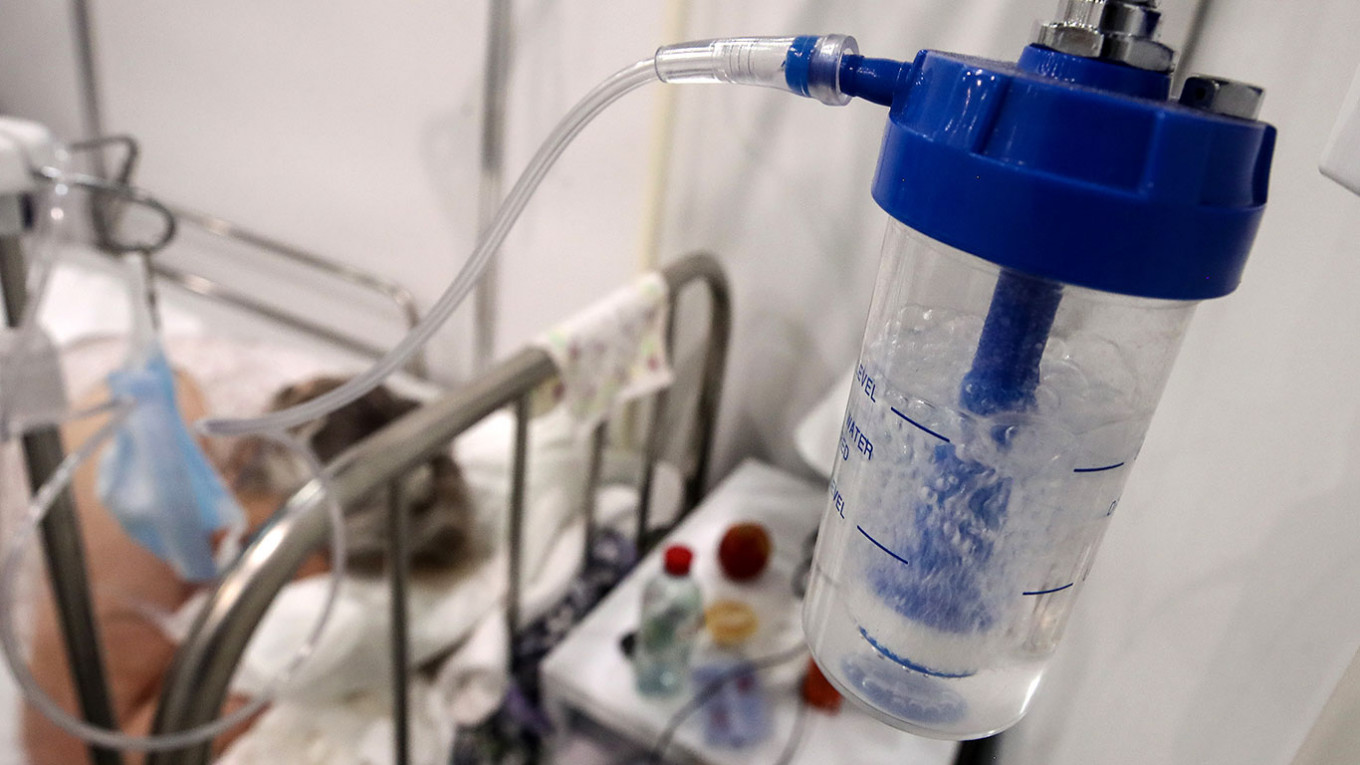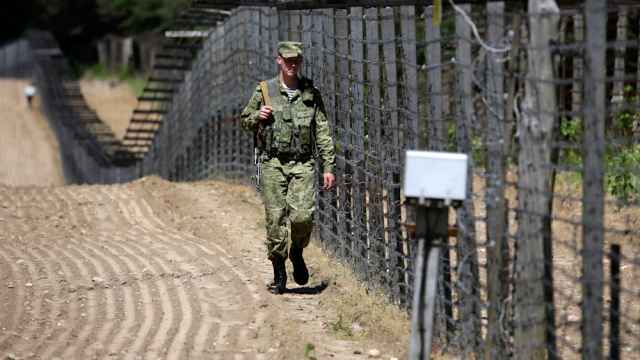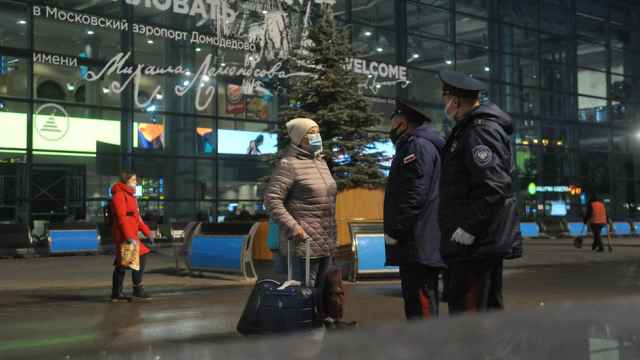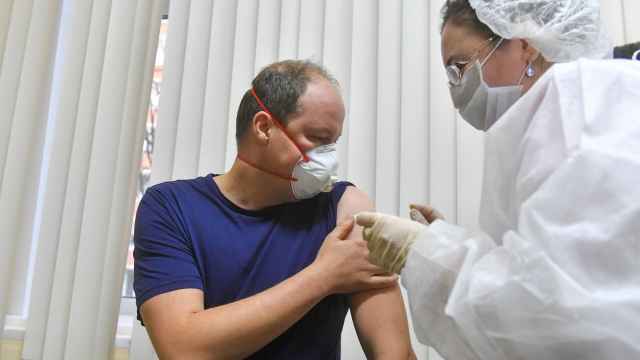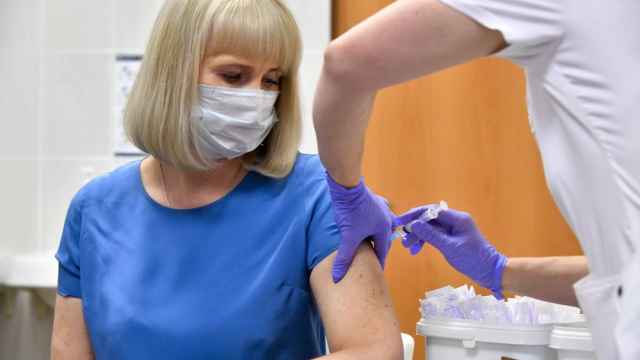Several Russian regions are facing medical oxygen shortages because of surging numbers of Covid-19 cases, doctors, oxygen suppliers and officials told The Moscow Times.
Hospitals are struggling to find supplies of liquid oxygen to boost the lung function of patients as the country continues to see consecutive daily death records and has gone into partial lockdown to curb the virus. The latest tally on Friday reported 1,163 fatalities, bringing the total to 236,220, Europe’s highest.
“I don’t want to sound hysterical, but the situation is very tense. There isn’t really a way we can scale up our production,” said Dmitriy Kuznetsov, the general manager of Cryogenmash, one of the three largest producers of medical oxygen in the country.
Kuznetsov said his company has scaled up “immensely” during the pandemic, and now produces 300 of the 2,000 metric tons of medical oxygen used each day in Russian hospitals.
“We are being as creative as we can in finding solutions because we understand the social responsibility we have,” he added.
Apart from isolated incidents, Russia has so far avoided widespread oxygen shortages similar to those seen in India last spring, where patients across the country died after hospitals ran out of supplies.
However, medics and suppliers say that during the latest wave of infections in a country where only 33% of adults are fully vaccinated, they are facing unprecedented demand.
“Since the beginning of the pandemic, the demand for medical oxygen has grown significantly. In some cases, we have seen a tenfold increase,” said Anna Zhemchugova, a spokeswoman for Linde, a German firm that, together with France’s Airliquide, is one of the two major producers of medical oxygen in Russia.
Zhemchogova said Linde has not come across oxygen shortages amongst its clients, but said the firm is working at “full capacity.”
Last week, the republic of Chuvashia, a region 600 kilometres east of Moscow was the first to raise alarm, when it declared a state of “high alert” due to oxygen shortages in hospitals
“The current situation is developing in a way that oxygen is running out,” the republic’s head Oleg Nikolaev told local media. Officials said that 99.5% of the region’s Covid-19 beds were occupied.
Speaking under condition of anonymity, two doctors working in the Infectious Diseases Hospital in Chuvashia’s capital Cheboksary warned that oxygen was running very low.
“We are getting to the point where we will have to choose who gets the oxygen,” one said.
In Russia’s isolated northern republic of Komi, the region’s head Vladimir Uyba said the situation was about “to burst.”
“Oxygen is the new gold. Every day we count out every bit and look at which cities and hospitals need it most. Soon, everything will burst. We will not have enough oxygen left,” Uyba told local media on Tuesday.
On Thursday, in a video address to the people of Komi, he repeated that the region had “huge problems with oxygen deficiency.”
Echoing Uyba, a medic working in Komi’s Infectious Diseases Hospital described the mood as “tense, borderline dramatic.”
“Sometimes the oxygen gets here at the very last minute, we feel like we are living on the edge.”
And in the Ural city of Perm, a medic told the local Ura News website that there had already been instances when they ran out of oxygen.
The Siberian Altai region and the North Ossetia republic in the Caucasus have also reported oxygen shortages.
In stark contrast to the provinces, Russia’s two biggest cities — Moscow and St. Petersburg — have not reported oxygen shortages.
Under current procedures, hospitals buy oxygen themselves in tenders from suppliers.
Transporting oxygen is difficult, experts say, with special tankers required to drive it in large quantities across the vast country.
“Most of the big oxygen suppliers like Linde and Air Liquide are located close to the bigger cities, so the situation there isn’t as critical,” said Artur Achmetdinov, the commercial director at Rev&Partners, which produces gas cylinders.
According to Achmetdinov, places located more than 200 kilometers from oxygen production facilities will now have problems getting oxygen.
“These places are suffering and facing unstable deliveries,” he said
Cryogenmash’s Kuznetsov said “it was expected” that Russia’s remote regions would be the ones suffering from lack of oxygen during the current coronavirus crisis.
“It’s not just an issue of producing enough oxygen, but also of getting that oxygen to those far-flung places and hospitals in time,” he said.
The problem is compounded by smaller hospitals in the regions, ill-equipped for a disease as serious as Covid-19, not always having the capacity to store large amounts of oxygen, Kuznetsov said.
Russia’s Industry and Trade Ministry, which is responsible for medical supplies in the country, last week admitted that bigger structural reasons were behind the recent problems.
“Unfortunately, these issues in the regions are often caused by a lack of storage and production of oxygen and lack of delivery vehicles,” the ministry told the RBK business outlet.
Big industry steps up
Russia took steps to try to avoid an oxygen shortage earlier this year, as experts were predicting a new coronavirus wave for the fall.
“The Industry and Trade Ministry really took charge and is now the one relocating oxygen to where it is needed,” Achmetdinov said.
In spring, the ministry started to speed up the issuing of licenses for the production of medical oxygen, urging companies like Cryogenmash to shift away from producing industrial oxygen.
“They made getting a licence much easier, it was very helpful. We got it quickly and were set up to produce medical oxygen,” said Kuznetsov.
Air Liquide, the French oxygen producer, said it had increased medical oxygen output by 600% since the start of the pandemic, and added new sites this summer.
“We also commissioned a new oxygen production site in the summer of 2021 and medicalized four new sites,” the company said in a statement.
Despite preparations, the latest wave of infection appears to have caught some Russian regions off guard.
"Some regions did not take into account lessons from previous waves of the pandemic and did not take sufficient measures, although we repeatedly warned them,” the Industry and Trade Ministry told the RBK business outlet.
One official at the trade ministry in Moscow linked the current Covid-19 restrictions directly to the oxygen shortages seen in the country.
“Things in the regions really aren’t looking very bright,” the official said, speaking on condition of anonymity.
“I believe many of the policies we are seeing now are driven by the fear of running out of oxygen.”
As has previously been the case during the pandemic, Russia has asked heavy industry to step up.
Medical oxygen accounts for roughly 5% of all the oxygen produced in the country, as most of it is used in the iron and steel industry.
First Deputy Minister of Industry Vasily Osmakov in early July, at the height of the third wave of the pandemic in Russia, ordered steel and metal companies to reduce their consumption of industrial oxygen to accommodate an increase in the supply of medical oxygen to hospitals.
Metalloinvest, a major steel producer owned by oligarch Alisher Usmanov said in a statement that it has been supplying more than 1,000 tons of medical oxygen per month to hospitals.
Other sectors have been asked to help too.
Earlier this month, Russia’s space chief Dmitry Rogozin said the country will suspend test firing of rocket engines at one of its design bureaus in the city of Voronezh to save oxygen supplies for Covid-19 patients.
"Our company alone supplies up to 33 tons of oxygen per day," Rogozin said.
And Russia’s Defense Ministry on Thursday said it had sent 27 regions in Russia a total of 347 tons of medical oxygen.
“All these steps will help, no doubt, but the results won’t be seen instantly”, said a senior manager at a mid-sized metal factory near Perm that has been redirected to produce medical oxygen.
“It takes time to readjust production for medical use.”
Oxygen used by hospitals differs from that used in industry as it is supplied in a more concentrated form.
“And this doesn’t solve some of the structural problems seen in hospitals. Russia simply needs to get Covid under control or else...,” the manager warned.
For now, despite record demand and profits at Cryogenmash, Kuznetsov hopes an uptick in vaccinations will ease the need for his company’s oxygen.
“I really want the vaccination campaign to finally kick off. But until then, we’ll be working day and night,” he said.



